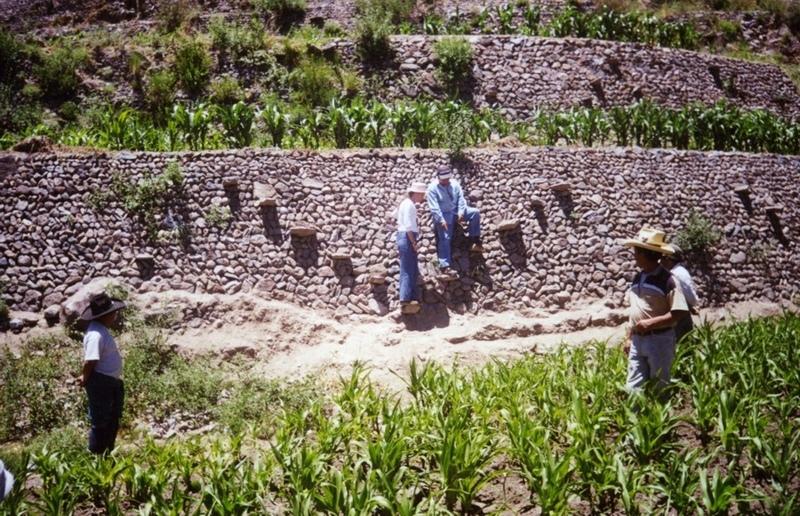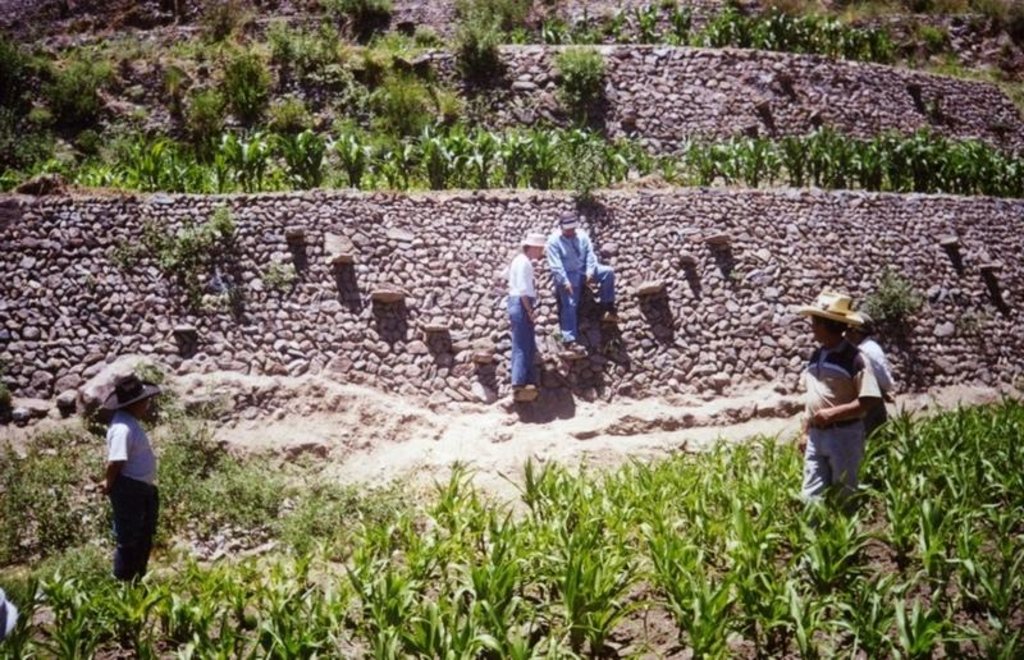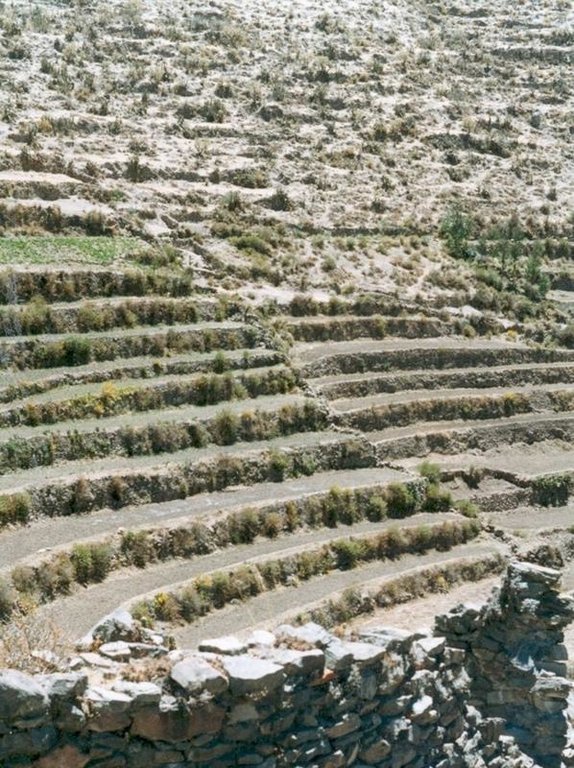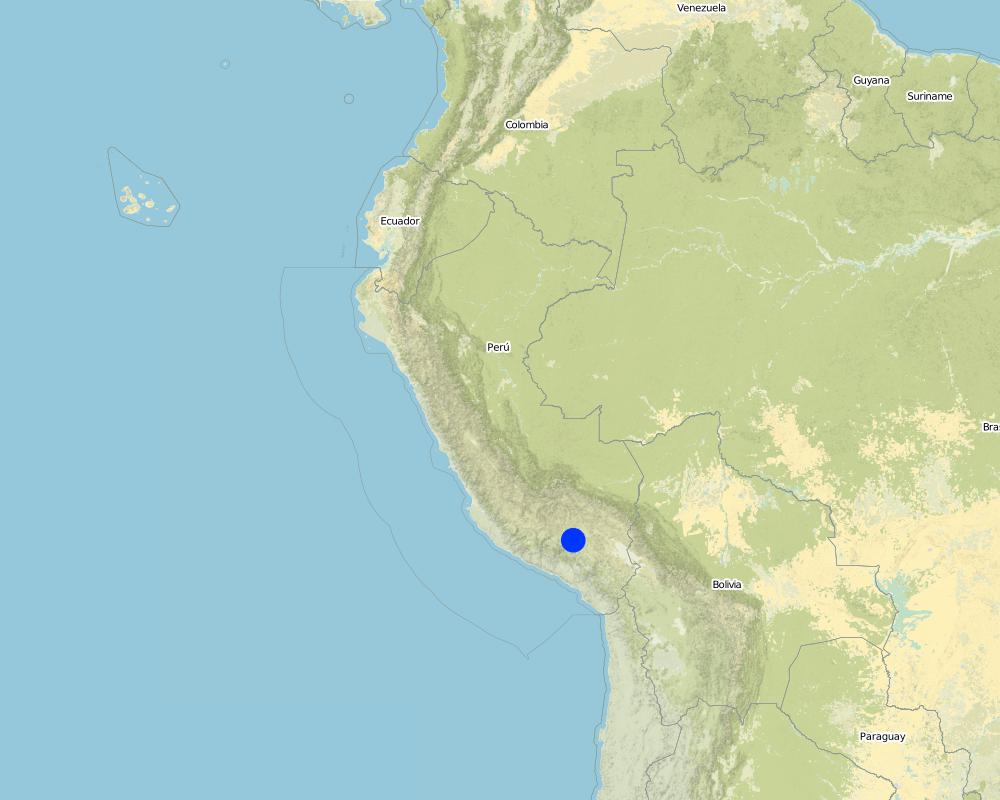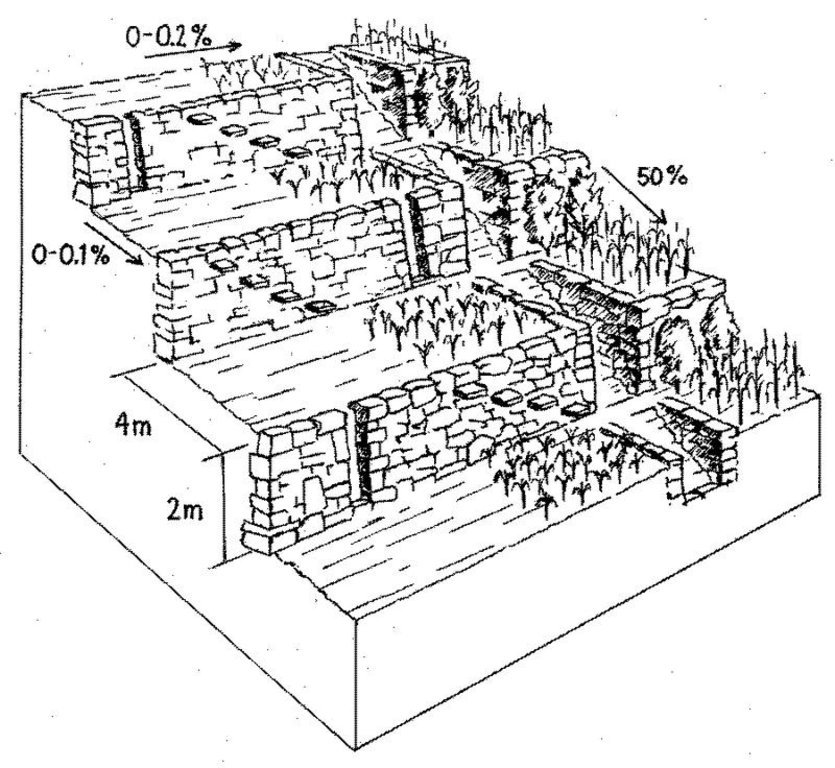Rehabilitation of ancient terraces [Перу]
- Создание:
- Обновить:
- Составитель: Unknown User
- Редактор: –
- Рецензенты: Fabian Ottiger, Alexandra Gavilano
Andenes / Anchacas / Patapatas
technologies_1506 - Перу
Просмотреть разделы
Развернуть все Свернуть все1. Общая информация
1.2 Контактные данные специалистов и организаций, участвующих в описании и оценке Технологии
Ответственный (-ые) специалист (-ы)
Специалист по УЗП:
Marquina Rodolfo
Centro de Estudios y Promoción del Desarrollo – DESCO
Перу
Название проекта, содействовавшего документированию/оценке Технологии (если применимо)
Book project: where the land is greener - Case Studies and Analysis of Soil and Water Conservation Initiatives Worldwide (where the land is greener)Название организации (-ий), содействовавших документированию/оценке Технологии (если применимо)
Centro de Estudios y Promoción del Desarrollo (DESCO) - Перу1.3 Условия, регламентирующие использование данных, собранных ВОКАТ
Составитель и ответственный(-ые) специалист(-ы) согласны с условиями, регламентирующими использование собранных ВОКАТ данных:
Да
1.5 Ссылка на Анкету (ы) по Подходам УЗП (документируется с использованием ВОКАТ)
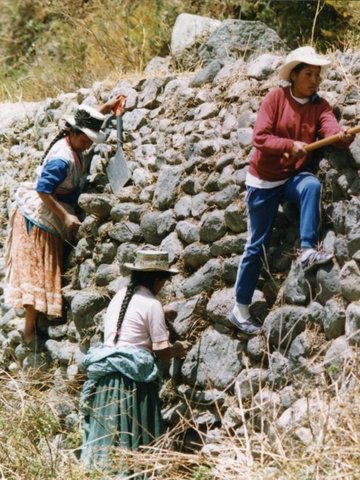
Participatory catchment rehabilitation (Participación comunitaria para la rehabilitación … [Перу]
Promoting the rehabilitation of ancient terrace systems based on a systematic watershed management approach.
- Составитель: Philippe Zahner
2. Описание Технологии УЗП
2.1 Краткое описание Технологии
Определение Технологии:
Repair of ancient stone wall bench terraces, and of an associated irrigation and drainage system.
2.2 Подробное описание Технологии
Описание:
The level bench terrace system in the Colca valley of Peru dates back to 600 years AD. Since then the terraces have been continuously used for crop production, but due to lack of maintenance they have deteriorated, and the population has lost its traditional knowledge of repair.
The rehabilitation of the terraces recreates their original structural design. Broken sections are cleared and the various materials - stones, topsoil, subsoil and weeds - are removed and separated. The foundation is re-established, followed by construction of the stone wall (the ‘riser’). Backfilling with subsoil then takes place; this is consolidated and finally covered with topsoil. Simultaneously the complementary irrigation and drainage systems are reconstructed.
The rehabilitated terraces efficiently conserve soil and water on steep slopes, and they create a favourable microclimate for crops, reducing loss of stored heat at night by minimising air movement (preventing frosts) and mitigating dry conditions through moisture conservation. The main economic benefits are from increased yields and crop diversification.
Terraces are spaced and sized according to slope, eg on a 50% slope, terraces are 4 m wide with a 2 m high riser between terrace beds. Stones of ancient terraces had been widely used to build walls for boundary marking after privatisation of land, therefore a large amount of stone had to be provided by splitting rocks and transporting from other locations.
The area is characterised by steep slopes with loamy-sandy, moderately deep soils (on the terrace beds). Most of the annual precipitation (ca. 350 mm) falls within a period of 3 months, which makes irrigation necessary. The farmers in the area own, on average, 1.2 hectares of arable land, divided into around six plots in different agro-ecological zones. Production is mainly for subsistence. Important supportive technologies include agronomic measures such as improved fallow, early tillage, ridging, and intercropping. Tree and shrub planting at the base of terrace walls is an optional measure with the aim of stabilising the walls, diversifying production and again ensuring a good microclimate. On average 250 trees/ha are planted; these are mainly native species such as c’olle (Buddleia spp.), mutuy (Cassia sp.), molle (Schinus molle: the ‘pepper tree’) and various fruit trees including capulí (Prunus salicifolia).
2.3 Фотографии, иллюстрирующие Технологию
2.5 Страна/ регион/ места, где применяется Технология, информация о которых собрана в данной Анкете
Страна:
Перу
Административная единица (Район/Область):
Río Colca,Caylloma, Arequipa
Пояснения:
Total area covered by the SLM Technology is 100 km2.
Map
×2.7 Внедрение Технологии
Укажите, как именно Технология УЗП была внедрена:
- через проекты/ внешнее вмешательство
3. Классификация Технологии УЗП
3.1 Основные цели и задачи реализации Технологии
- повышение производства
- снижение или предотвращение деградации земель, восстановление нарушенных земель
- создание благоприятных экономических условий
3.2 Текущий(-ие) тип(-ы) землепользования на территории, где применяется Технология

Пахотные угодья и плантации
- Однолетние культуры
Ежегодный урожай - Уточните культуры:
- зерновые культуры - кукуруза
- кормовые культуры - люцерна
- бобовые - бобы
- корневые / клубнеплодные культуры - картофель
Поясните:
Longest growing period in days: 120 Longest growing period from month to month: Dec - Apr

Пастбищные угодья
Интенсивный выпас/ выращивание кормов:
- Стойловое содержание/ нулевой выпас
Пояснения:
Main crops (cash and food crops): Major food crop: Potatoes, maize,beans, etc
Main animal species and products: Alfalfa (cut and carry)
Major land use problems (compiler’s opinion): - Loss of productive capacity: 30% of the agricultural land lost due to degraded terraces, severe deforestation (through
cutting for fuelwood), overgrazing and burning of grazing areas.
- Inefficient irrigation practices (flooding) due to poor maintenance of irrigation system (and drainage system in poor
condition), flood irrigation leads to deterioration of terraces.
- Loss of traditional knowledge of ancestral crop management practices (abandonment of appropriate rotation practices, lack of residue incorporation/recycling, unsystematic crop layout).
3.4 Водоснабжение
Пояснения:
Water supply: mixed rainfed - irrigated and rainfed
3.5 Категория УЗП, к которой относится Технология
- мероприятия по влагозадержанию и снижению эрозии почв на склонах
- Управление орошением (включая водоснабжение и дренаж)
- Водоотвод и осушение
3.6 Мероприятия УЗП, выполняемые в рамках Технологии

инженерные мероприятия
- И1: Террасирование
Пояснения:
Main measures: structural measures
Secondary measures: agronomic measures, vegetative measures
3.7 Основные проблемы деградации земель, на решение которых направлена Технология

водная эрозия почв
- ВЭп: поверхностная эрозия/смыв верхних почвенных горизонтов
- ВЭл: овражная эрозия / оврагообразование

ухудшение химических свойств почв
- Хп: Снижение плодородия и уменьшение содержания органического вещества (вызванное не эрозией, а другими причинами)

деградация водных ресурсов
- Ва: почвенная засуха
Пояснения:
Main type of degradation addressed: Wt: loss of topsoil / surface erosion, Wg: gully erosion / gullying, Cn: fertility decline and reduced organic matter content, Ha: aridification
3.8 Предотвращение и снижение деградации земель, или восстановление нарушенных земель
Укажите цель Технологии по отношению к деградации земель :
- восстановление/ реабилитация нарушенных земель
4. Технические характеристики, мероприятия по практической реализации, вложения и стоимость
4.1 Технический рисунок, иллюстрирующий Технологию
Спецификация (пояснения к техническому рисунку):
Rehabilitated ancient terraces with high stone risers. Two options for irrigation and drainage of excess water are shown: outlets in the risers (left) and a broad water channel cutting perpendicularly through the terraces (right).
Technical knowledge required for field staff / advisors: high
Technical knowledge required for land users: moderate
Main technical functions: control of dispersed runoff: retain / trap, reduction of slope angle, reduction of slope length, increase of infiltration, water harvesting / increase water supply, improvement of microclimate
Secondary technical functions: control of dispersed runoff: impede / retard, control of concentrated runoff: impede / retard, increase in organic matter, increase / maintain water stored in soil, sediment retention / trapping, sediment harvesting, improvement of soil structure
Автор:
Mats Gurtner
4.3 Мероприятия, необходимые для начала реализации
| Деятельность | Время (сессия) | |
|---|---|---|
| 1. | Separation of materials of collapsed wall: subsoil, topsoil, stone, weeds. | dry period. |
| 2. | Cleaning and re-establishment of the foundation according to originalstructure. | dry period. |
| 3. | Cutting stones from rocks (blasting and splitting); transporting. | dry period. |
| 4. | Reconstruction of the stone wall, building on the basis of remainingintact structures of ancient terraces; simultaneous reconstructionof irrigation channels and complementary structures. | dry period. |
| 5. | Backfilling with subsoil, moistening soil and consolidation with motor | dry period. |
| 6. | Covering with fertile topsoil. | dry period. |
| 7. | Levelling of terrace bed and completion of riser edge (lip). | dry period. |
| 8. | Planting of trees below terrace walls (optional). | dry period. |
| 9. | Improved fallow, early tillage, ridging, and intercropping (supportivemeasures). | dry period. |
4.4 Вложения и затраты, необходимые для начала реализации
| Опишите затраты | Единица | Количество | Затраты на единицу | Общая стоимость на единицу | % затрат, оплаченных землепользователями | |
|---|---|---|---|---|---|---|
| Оплата труда | Labour | ha | 1,0 | 560,0 | 560,0 | 40,0 |
| Оплата труда | Construction supervisor (days) | ha | 1,0 | 60,0 | 60,0 | |
| Оборудование | Machine use | ha | 1,0 | 180,0 | 180,0 | 40,0 |
| Оборудование | Tools | ha | 1,0 | 300,0 | 300,0 | 40,0 |
| Посадочный материал | Seedlings | ha | 1,0 | 100,0 | 100,0 | |
| Строительные материалы | Stone | ha | 1,0 | 200,0 | 200,0 | 40,0 |
| Общая стоимость запуска Технологии | 1400,0 | |||||
| Общие затраты на создание Технологии в долларах США | 1400,0 | |||||
4.5 Поддержание/ текущее обслуживание
| Деятельность | Сроки/ повторяемость проведения | |
|---|---|---|
| 1. | Irrigation system cleaning. | |
| 2. | Clearing weeds from stone wall | (dry season)./ |
| 3. | Inspection of the stone walls’ stability | (before sowing)./ |
| 4. | Repair structures | (rainy season)./ |
| 5. | Tree and root pruning. |
4.6 Стоимость поддержания/ текущего обслуживания ( в год)
| Опишите затраты | Единица | Количество | Затраты на единицу | Общая стоимость на единицу | % затрат, оплаченных землепользователями | |
|---|---|---|---|---|---|---|
| Оплата труда | Labour | ha | 1,0 | 25,0 | 25,0 | 100,0 |
| Оборудование | Tools | ha | 1,0 | 100,0 | 100,0 | 100,0 |
| Общая стоимость поддержания Технологии | 125,0 | |||||
| Общие затраты на поддержание Технологии в долларах США | 125,0 | |||||
Пояснения:
Machinery/ tools: A-frame,tape measure,motor drill,wheelbarrow,shovel,pick,steel bar,sledgehammer,hoe,hand compressor.
Person days needed for rehabilitation of 1 ha of ancient terrace system depend on degree of deterioration, the dimensions of the wall, slope angle (the steeper the more terraces) and availability of stones. In the case of the project, under a typical situation, for physical rehabilitation of 1 ha with 6 terraces, each ca 600 m long, 3–4 m wide and 2 m high, with one third of the main structures in disrepair, 18 men and 7 women work for 5 days; shrub planting is extra. Land users bear 35% of the overall costs: they also provide food for the group during work. The programme pays the rest. 450 m3 of additional stones are required to repair the broken parts, the cost includes blasting/splitting rocks and transport to the construction site.
Supportive agronomic measures and agricultural inputs (seeds and manure) are not included. Maintenance costs vary considerably, depending on the specific situation: an average is taken here.
5. Природные и социально-экономические условия
5.1 Климат
Среднегодовое количество осадков
- < 250 мм
- 251-500 мм
- 501-750 мм
- 751-1000 мм
- 1001-1500 мм
- 1501-2000 мм
- 2001-3000 мм
- 3001-4000 мм
- > 4000 мм
Агроклиматическая зона
- полузасушливая
5.2 Рельеф
Склоны (преобладающие):
- пологие (0-2%)
- покатые (3-5%)
- покато-крутые (6-10%)
- крутые (11-15%)
- очень крутые (16-30%)
- чрезвычайно крутые (31-60%)
- обрывистые (>60%)
Формы рельефа:
- плато/ равнины
- гребни хребтов/холмов
- склоны гор
- склоны холмов
- подножья
- днища долин
Зона высотной поясности:
- 0-100 м над уровнем моря
- 101-500 м н.у.м.
- 501-1000 м н.у.м.
- 1001-1500 м н.у.м.
- 1501-2000 м н.у.м.
- 2001-2500 м н.у.м.
- 2501-3000 м н.у.м.
- 3001-4000 м н.у.м.
- > 4 тыс. м н.у.м.
Комментарии и дополнительные сведения по условиям рельефа/ топографии :
Landforms: Also hill slopes (ranked 2) and footslopes (ranked 3)
Slopes on average: Also hilly (ranked 2) and rolling (ranked 3)
5.3 Почвы
Средняя мощность почв:
- поверхностные (0-20 см)
- неглубокие (21-50 см)
- умеренно глубокие (51-80 см)
- глубокие (81-120 см)
- очень глубокие (> 120 см)
Гранулометрический состав (верхнего горизонта):
- средние фракции (суглинистый, супесчаный)
Содержание органического вещества в верхнем горизонте:
- низкое (< 1%)
Если возможно, приложите полное описание почв или укажите доступную информацию, например тип почв, рH/ кислотность почв, ёмкость катионного обмена, содержание азота, содержание солей и т.д.
Soil fertility: Medium (ranked 1, used for maize) and low (ranked 2)
Topsoil organic matter: Low (low recycling of organic matter)
Soil drainage/infiltration: Medium
5.6 Характеристика землепользователей, применяющих Технологию
Доходы из других источников:
- < 10% всех доходов
Укажите другие важные характеристики землепользователей:
Off-farm income specification: main source is wage labour in the valleys
Market orientation of grazing land production system: Subsistence (ranked 1) and mixed (ranked 2, 30% for market)
Market orientation of grazing land production system: Subsistence (ranked 1, complementary to crop production) and commercial/market (ranked 2, income generation to meet basic needs)
5.7 Средняя площадь земель, используемых землепользователями с применением Технологии
- < 0,5 га
- 0,5-1 га
- 1-2 га
- 2-5 га
- 5-15 га
- 15-50 га
- 50-100 га
- 100-500 га
- 500-1000 га
- 1000-10000 га
- > 10000 га
Пояснения:
Average area of land owned or leased by land users applying the Technology: Also 2-5 ha (ranked 3)
5.8 Собственность на землю, права на земле- и водопользование
Землевладелец:
- индивидуальная, не оформленная в собственность
- индивидуальная, оформленная в собственность
Право землепользования:
- аренда
- индивидуальное
6. Воздействия и заключительные положения
6.1 Влияние Технологии УЗП в пределах территории ее применения
Социально-экономическое воздействие
Продуктивность
производство сельскозяйственных культур
Комментарий/ пояснения:
Average 30%
управление землями
Комментарий/ пояснения:
Careful management required (water and livestock)
Доходы и затраты
доходы хозяйства
объем работ
Комментарий/ пояснения:
Easier crop management (level bench, alignment of crops). On the other hand increased labour constraints: heavy work, const. Maintenance. Heavy work by establishment
Другое социально-экономическое воздействие
Efficiency
Комментарий/ пояснения:
Efficient use of irrigation water and fertilizers
Input constraints
Комментарий/ пояснения:
Tools
Ccarcity of stones (in some places)
Экологическое воздействие
Водный цикл/ поверхностный сток
водный дренаж
Почвы
влажность почв
почвенный покров
утрата почв
круговорот/ восполнение питательных веществ
Биоразнообразие: растительность, животный мир
разнообразие флоры
разнообразие фауны
разнообразие местообитаний
Другие экологические последствия
Regular crop growth and development
Improved microclimate
Комментарий/ пояснения:
Reduced wind; conserving heat
6.2 Влияние Технологии за пределами территории ее применения
надежность и постоянство водотоков
подтопление ниже по течению
отложение наносов ниже по течению
6.4 Анализ эффективности затрат
Насколько получаемый результат сопоставим с первоначальными вложениями (с точки зрения землепользователей)?
Эффективность затрат в краткосрочной перспективе:
влияние незаметно
Эффективность затрат в долгосрочной перспективе:
очень позитивное
Насколько получаемый результат сопоставим с текущими расходами по поддержанию технологии (с точки зрения землепользователей)?
Эффективность затрат в краткосрочной перспективе:
позитивное
Эффективность затрат в долгосрочной перспективе:
очень позитивное
6.5 Внедрение Технологии
Если возможно, дайте количественную характеристику (число домохозяйств и/или площадь применения):
240
Среди применяющих Технологию землепользователей, какова доля лиц, применяющих её по собственной инициативе, т.е. без какого-либо материального стимулирования со стороны?
- 11-50%
Пояснения:
90% of land user families have adopted the Technology with external material support
2160 land user families have adopted the Technology with external material support
10% of land user families have adopted the Technology without any external material support
240 land user families have adopted the Technology without any external material support
There is a moderate trend towards spontaneous adoption of the Technology
Comments on adoption trend: There is a moderate trend towards spontaneous adoption.
40% of terraces have been rehabilitated in 7 districts (8 micro-watersheds) of the Colca valley.
6.7 Сильные стороны/ преимущества/ возможности Технологии
| Сильные стороны/ преимущества/ возможности по мнению землепользователей |
|---|
|
Facilitation of crop management activities (crop alignment, easier tillage with oxen plough, efficiency of pest control, etc) How can they be sustained / enhanced? Appropriate crop management (see measures mentioned in description). |
|
Improved microclimate facilitates crop growth and crop diversification How can they be sustained / enhanced? Complete with improved agronomic practices and agroforestry. |
|
Increased yields and food security How can they be sustained / enhanced? Conserve crop diversity and genetic variety. |
|
Cultural heritage How can they be sustained / enhanced? Conservation of traditional practices |
| Facilitation of crop management activities (crop alignment, easier tillage with oxen plough, efficiency of pest control, etc)-->Appropriate crop management (see measures mentioned in description). - Improved microclimate facilitates crop growth and crop diversification-->Complete with improved agronomic practices and agroforestry. - Increased yields and food security-->Conserve crop diversity and genetic variety Cultural heritage-->Conservation of traditional practices. |
| Сильные стороны/ преимущества/ возможности по мнению составителя или других ключевых специалистов |
|---|
|
Traditional technology is of great value and adapted to local conditions How can they be sustained / enhanced? Awareness raising of the local population on maintenance of terraces. |
|
Successful implementation is product of evaluation, analysis and documentation of experiences How can they be sustained / enhanced? Further appraisal of the technology. |
|
Soil maintained on steep slopes, no soil loss due to water erosion How can they be sustained / enhanced? Continuous maintenance and appropriate management through training. |
|
More efficient use of irrigation/rain water, longer storage of soil moisture How can they be sustained / enhanced? Permanent maintenance of structure. |
|
Maintenance of soil fertility How can they be sustained / enhanced? Recycling of organic matter. |
6.8 Слабые стороны/ недостатки/ риски Технологии и пути их преодоления
| Слабые стороны/ недостатки/ риски по мнению землепользователей | Возможные пути их преодоления/снижения? |
|---|---|
| Vulnerability of terraces to damage by grazing animals | Do not allow grazing on short terraces with high stone walls. |
| Land users are not skilled in repair of broken sections in the terrace system | More training on maintenance and conservation. |
| Vulnerability of terraces to damage by grazing animals-->Do not allow grazing on short terraces with high stone walls. - Land users are not skilled in repair of broken sections in the terrace system-->More training on maintenance and conservation. Editors’ comments: Terracing systems on hillsides date back to the beginning of agriculture. Often these feature walls (‘risers’) built of stone, and sometimes they are used for irrigation – as in this case from Peru. While many ancient systems have fallen into disrepair with out-migration of rural populations, this is an example of project-based rehabilitation. |
| Слабые стороны/ недостатки/ риски по мнению составителя или ответственных специалистов | Возможные пути их преодоления/снижения? |
|---|---|
|
Specialised work, not easy to carry out – complex system of different structures |
Promote applied research and extension. |
|
High rehabilitation costs; increased by loss of traditional forms of reciprocal work, and a trend towards individualism |
Reactivate and strengthen traditional labour systems based on reciprocity and mutual help. |
| Limited availability of stones impedes the rehabilitation process |
Carry stones from adjacent or remote places, give training in rock splitting. |
| Not appropriate for use of agricultural machines | Awareness creation. |
| Private properties, but not titled |
Promote the legalisation of titles to facilitate the access to credit and technical assistance. |
7. Справочные материалы и ссылки
7.1 Методы сбора/ источники информации
7.2 Ссылки на опубликованные материалы
Название, автор, год публикации, ISBN:
Mejia Marcacuzco AP Folleto de divulgación: Andenes, construcción y mantenimiento. (undated).
Название, автор, год публикации, ISBN:
Treacy, JM (undated) LasChacras de Coporaque: Andenes y riego en el valle del Colca. Instituto de Estudios Peruanos. DESCO
Ссылки и модули
Развернуть все Свернуть всеСсылки

Participatory catchment rehabilitation (Participación comunitaria para la rehabilitación … [Перу]
Promoting the rehabilitation of ancient terrace systems based on a systematic watershed management approach.
- Составитель: Philippe Zahner
Модули
Нет модулей


